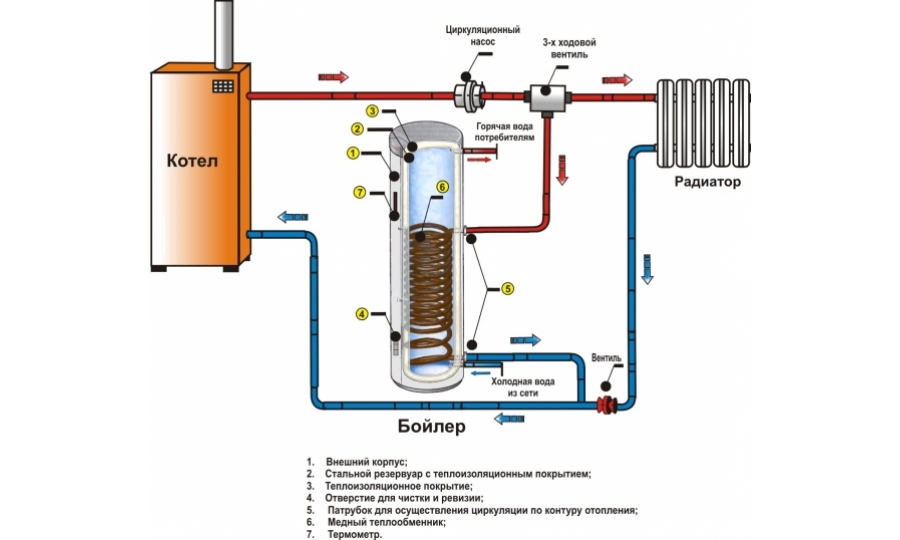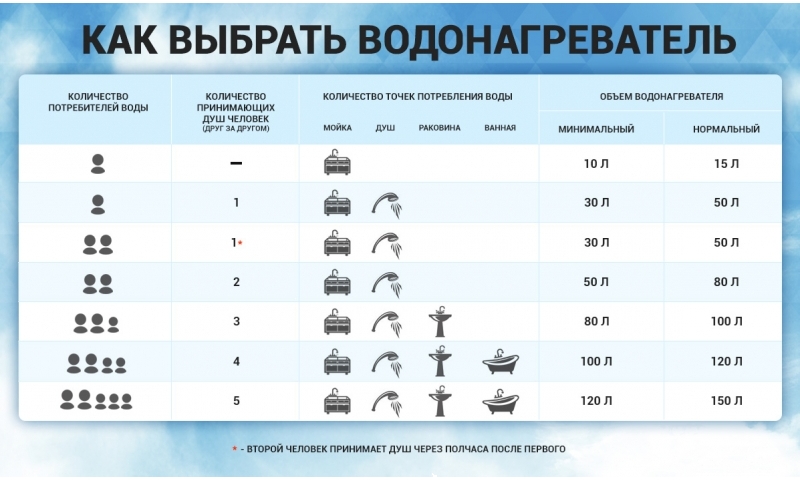Using an indirect heating boiler
An indirect heating boiler is designed to increase the comfort of hot water supply. Devices of this type can be used as domestic sources or in small enterprises with an increased demand for hot water. Indirect heating boilers are similar to storage water heaters, but instead of electricity or gas, a heat exchanger is installed in them. Hot water is heated by connecting heat exchangers to a heating system or other source of energy.
Design
What is an indirect water heating boiler and why should it be installed? To find the answer to this question, it is advisable to consider the device of an indirect heating boiler. By analogy with storage heaters, the units consist of the following elements:
- water tank with fittings for its supply and withdrawal;
- a layer of thermal insulation material;
- external metal or plastic coating;
- control and management devices.
This is where the similarity ends. There is no electric heating element in the classic design. To heat the water, a coil is used, which is connected through additional fittings to the heating system or another source of hot water. The change in the temperature of the heated medium occurs due to heat transfer through the walls of the tube. The boiler device for heating differs depending on the shape and size of the heating element. It could be:
- a tube bent into a spiral or spring;
- a set of straight tubes flared in tube sheets;
- additional tank.
![]()
For the manufacture of heat exchangers, stainless steel or brass tubes are used. The main requirement is a small wall thickness, which ensures the most efficient heat transfer without sacrificing strength.
A modern water heater of indirect heating, in addition to the main heat exchanger, is equipped with a backup heat source. Some models may have a gas heater or an electric heating element. Models are produced in which an additional coil is installed for connection to solar panels. The general name for boilers with alternative heat sources is combined. To combat scale, all devices are equipped with a magnesium electrode.
Method of work
How does an indirect heating boiler work? It's very simple: hot water or other liquid circulates inside the coil or component that replaces it. The coil, heating up, transfers heat to the external environment, that is, to the water filling the tank. After a certain period of time, hot water is heated to the temperature of the carrier, and the heat transfer process is reduced to a minimum value. When the temperature drops due to heat loss or water withdrawal, the indirect heater starts heating the water again.
Modern materials with a high degree of thermal insulation provide minimal heat loss, so in the absence of analysis, the temperature of hot water will change slightly.

A more important point is to connect the hot water boiler to the heating system. There are two main ways:
- serial connection;
- parallel connection.
When connected in series, the flow of hot water will pass through the heat exchanger and then go to the heating system. This method requires an increase in the temperature at the outlet of the boiler and a certain throughput of the boiler. The advantages of such a connection are in a higher temperature of the heated medium, which means that its consumption can be reduced by diluting it in a mixer with a cold one.
The disadvantage is the need to stop the heating system in case of device malfunctions that require access to the internal space. This shortcoming is easy to eliminate. The connection diagram may contain a bypass line and shut-off valves to shut off the unit.
Parallel connection is a normal connection to a heating system. The indirect water heater is connected to the supply and return pipes, respectively. Circulation and heat transfer take place as in a conventional radiator. The advantage of such a system is the ease of maintenance and repair; the disadvantage is the lower outlet water temperature.
Criterias of choice
Having dealt with the question of what an indirect heating boiler is, you can consider the properties of these units. The advantages of indirect type boilers include:
- the possibility of heating and storing a large amount of water;
- smoothing the effect of peak loads;
- reduction of costs for the production of hot water;
- the possibility of parsing water at several points;
- use of additional heat sources.
The most effective is the use of heaters if a gas heating boiler is installed in the house. All gas appliances have an automatic system that maintains the set temperature. When a certain maximum value is reached, the burner turns off, when it decreases, it automatically turns on.

A sequential scheme for operating a boiler for heating water will increase the time interval between turning off and turning on the burner.
When the temperature of the heating system drops, the return heat transfer from the boiler will start. This effect will not have a significant effect on the water temperature, but the gas consumption will decrease.
Disadvantages:
- high acquisition and installation costs;
- long period of initial warming up;
- equipment is large.
Based on the considerations presented above, you can navigate and choose the most suitable device for your home. Also, the disadvantages include the installation of an additional circulation pump with alternative heating options.
Like all devices, boilers are not the solution to all problems. The storage water heater also has impressive dimensions; in most cases, a flow-through water heater can ensure parsing at only one point. The advantages of the device will be especially pronounced with a large number of residents: in a large family or with several generations living under the same roof.









